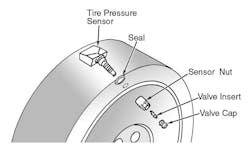SUBJECT VEHICLE: 2008-09 Mitsubishi Eclipse.
SENSOR IN TIRE? No (sensors located on the wheel).
RESET PROCEDURE? Yes (whenever the TPMS receiver or transmitter is replaced).
SPECIAL TOOLS NEEDED? Yes (TPMS Magnet MIT46716; Scan Tool MUT-III Sub Assembly MB991958; the Vehicle Communication Interface V.C.I. MB991824; the MUT-III USB Cable MB991827; and the MUT-III Main Harness A MB991910).
The tire pressure monitoring system (TPMS) in the 2008-09 Mitsubishi Eclipse consists of the following components: four TPMS transmitters, a TPMS antenna, a TPMS receiver and a TPMS warning indicator.
The transmitters are located on the wheel well and have a built-in tire pressure sensor. The transmitters measure tire pressure levels and send the data via radio frequency to the antenna. The TPMS antenna translates the signal and determines whether or not the TPMS warning indicator needs to be illuminated.
When the ignition switch is in the ON position, the warning light will remain illuminated if one or more of the vehicle’s tires exhibits low pressure. If the pressure level is lower than 25.3 psi, the TPMS warning indicator will illuminate.
[PAGEBREAK]
Sensor swap
Before you can exchange the TPMS sensors, you must first demount the tire using the tire changer manufacturer’s instructions. Follow these steps:
1. Remove the tire and wheel assembly from the vehicle and remove the valve cap.
2. Rotate the tire so that the valve stem is in the 6 o’clock position.
3. Using a long reach 17.2 mm socket, unscrew the valve nut a couple of turns (see Figure 1). Slowly push the valve stem into the tire so that the tire pressure is relieved. Then remove the valve nut.
4. Place on the tire changing machine. Break both beads, making sure that the tire pressure sensor remains in the bottom of the tire.
5. Lubricate the tire and remove the outer side of the tire.
6. Reach inside the tire and remove the TPMS transmitter.
7. Using a soft tool, remove the grommet to prevent scratching the sensor valve.
8. Remove the grommet from the tire pressure monitoring system transmitter.
To install the new sensor, follow these steps:
1. Slide the inner tire bead over the rim face.
2. Install a new grommet to the TPMS transmitter.
3. Ensure that the grommet is located inside the valve hole before installing the valve nut. While installing the nut, hold the valve and grommet in contact with the rim. After installing the nut, ensure the grommet is compressed.
4. Mount the TPMS transmitter valve through the rim hole. Both holes in the sensor should face away from the center of the rim.
5. Tighten the valve nut finger tight. Slowly tighten the valve nut to 43 to 53 in.-lb. At this point, make sure that the transmitter has been assembled correctly. One side of the lower lip of the TPMS transmitter can touch the rim after torquing.
6. Place the wheel and tire on the turntable of the tire mounting machine. Ensure that the transmitter is 270 degrees from the mounting head when the outer bead is mounted. Lubricate and mount the bead as normal.
7. Install the tire on the wheel and install the tire/wheel assembly on the vehicle.
8. Inflate the tire to specification. Retighten the valve nut to 49 in.-lb.
Now you’re ready to register the TPMS transmitter.
[PAGEBREAK]
Registration process
If the TPMS receiver or transmitter has been replaced, you must register the tire pressure sensors.
The following tools are required: TPMS Magnet (MIT46716); Scan Tool (MUT-III Sub Assembly MB991958); the Vehicle Communication Interface (V.C.I. MB991824); the MUT-III USB Cable (MB991827); and the MUT-III Main Harness A (MB991910).
To prevent damage to Scan Tool (MB991958), always turn the ignition switch to the OFF position before connecting or disconnecting the scan tool. Follow these steps:
1. Connect the scan tool to the Data Link Connector (DLC) with the ignition switch in the OFF position.
2. Turn the ignition switch ON.
3. Select “INTERACTIVE DIAGNOSIS” from the start-up screen.
4. Select “SYSTEM SELECT.”
5. Choose “TPMS” from the “CHASSIS” tab.
6. Select “MITSUBISHI,” then select “SPECIAL FUNCTION.”
7. Select “TIRE PRESSURE SENSOR ID REGISTRATION.”
8. Select “4 TIRES PRES SNSR ID REGISTRATION (COMPACT SPARE TIRE)” and start sensor registration. Note that all sensors must be registered within five minutes. Sensor registration has no sequential order. You may begin at any tire.
9. Emit the signal from the sensor by cleaning the sensor located on the rim, then positioning the TPMS Magnet (MIT46716) or a strong magnet and holding it there for five seconds or more (see Figure 2).
The reed switch will active the sensor to send the ID.
10. Using the scan tool, ensure the sensor has been activated.
11. Repeat steps 8 through 10 for all tires.
12. Check completion of the tire sensor ID registration by examining the display on screen.
13. After you have completed the registration process, turn the ignition switch to the OFF position. Remove the scan tool and ensure that the warning light does not illuminate or flash.
The TPMS may not function properly under the following conditions: a wireless device using the same frequency as the pressure sensor is near the vehicle; snow or ice is stuck inside the wheel housing and/or the wheels themselves; and wheels other than Mitsubishi rims are being used. Use of wheels whose pressure sensor IDs are not registered by the vehicle also may pose a problem. ■
Information for this column comes from Mitchell 1’s ”Tire Pressure Monitoring Systems Guide” for domestic and import vehicles through 2008. Headquartered in Poway, Calif., Mitchell 1 has provided quality repair information solutions to the automotive industry for more than 80 years. For more information, visit www.mitchell1.com.



